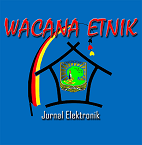METAFORA PADA DESAIN KAOS PRODUKSI KAPUYUAK DAN KONCO CLOTHING
Abstract
This article describes the use of metaphoric words of T-shirt design produced by the Kapuyuak and Konco Clothing stores. T-shirts in both stores contain many metaphors about the daily life of Minangkabau people. This study discusses metaphorical forms and functions in the product's design of those two shops. The theory used is the theory of the metaphor form proposed by Stephen Ullman and the theory of functions by Geoffrey Leech.
The results show metaphorical forms in the T-shirts design produced by the Kapuyuak and Konco Clothing stores, which are 6 anthropomorphic metaphors, 4 animal metaphors, 7 metaphors from concrete to abstract, and 3 synaesthetic metaphors. Whereas, the functions found are 4 informational functions, 4 expressive functions, 1 directive function, 1 fatigue function, and 10 aesthetic functions.
Keywords: metaphor, shirt design, metaphorical form, metaphorical function
Keywords
Full Text:
PDFReferences
Anwar, K. (1992). Semantik Bahasa Minangkabau. Padang: Yayasan Pengkajian Minangkabau.
Campbell, D. a. (1996). Design in Virtual Environments Using Architectural Metaphor. University of Washington. Retrieved from http://cumincad.scix.net/cgi-bin/works/Show?_id=b27f&sort=DEFAULT&search=virtual reality&hits=2442
Casakin, H. (2012). An empirical assessment of metaphor use in the design studio: analysis, reflection and restructuring of architectural design. International Journal of Technology and Design Education, 22(3), 329–344. https://doi.org/10.1007/s10798-010-9149-x
Ekow, A., & Vincentia, A. (2013). Sirigu Symbols : A Metaphoric Element for Batik Prints. Arts and Design Studies, 12, 49–58.
Janesick, V. J. (1994). The dance of qualitative research design: Metaphor, methodolatry, and meaning. - PsycNET. In Handbook of qualitative research (pp. 209–219). Thousand Oaks: Sage Publications, Inc. Retrieved from https://psycnet.apa.org/record/1994-98625-011
Johnson, N. R. (2006). Metaphor and Design. Studies in Art Education, 33(3), 144–153. https://doi.org/10.1080/00393541.2006.11650084
Kridalaksana, H. (2008). Kamus Linguistik. Jakarta: Gramedia.
Luxemburg, J. Van, Bal, M., & Westseijn, W. G. (1989). Pengantar Ilmu Sastra. (Dick Hartoko, Ed.). Jakarta: Gramedia. Retrieved from http://library.um.ac.id/free-contents/index.php/buku/detail/pengantar-ilmu-sastra-jan-van-luxemburg-mieke-bal-willem-g-westseijn-diindonesiakan-oleh-dick-hartoko-3776.html
Marcus, A. (1998). Metaphor design in user interfaces. ACM SIGDOC Asterisk Journal of Computer Documentation, 22(2), 43–57. https://doi.org/10.1145/291391.291397
Noble, J., Biddle, R., & Tempero, E. (2002). Metaphor and metonymy in object-oriented design patterns. Australian Computer Science Communications, 24(1), 360. Retrieved from https://dl.acm.org/citation.cfm?id=563823
Saffer, D. (2005). The Role of Metaphor in Interaction Design. Citeseer. Carnegie Mellon University.
Schwen, T. M., & Hara, N. (2003). Community of Practice: A Metaphor for Online Design? The Information Society, 19(3), 257–270. https://doi.org/10.1080/01972240309462
Stubblefield, W. A. (1998). Patterns of Design In Change Metaphors.pdf. In ACM computer human interaction conference. Los Angeles.
Tarigan, H. G. (1995). Pengajaran Semantik. Bandung: Angkasa.
Ullmann, S. (2007). Pengantar Semantik. (Sumarsono, Ed.). Yogyakarta: Pustaka Pelajar.
DOI: http://dx.doi.org/10.25077/we.v6.i2.69
Refbacks
- There are currently no refbacks.
REPOSITORI / TERINDEKS DALAM
STATISTIK PENGUNJUNG














